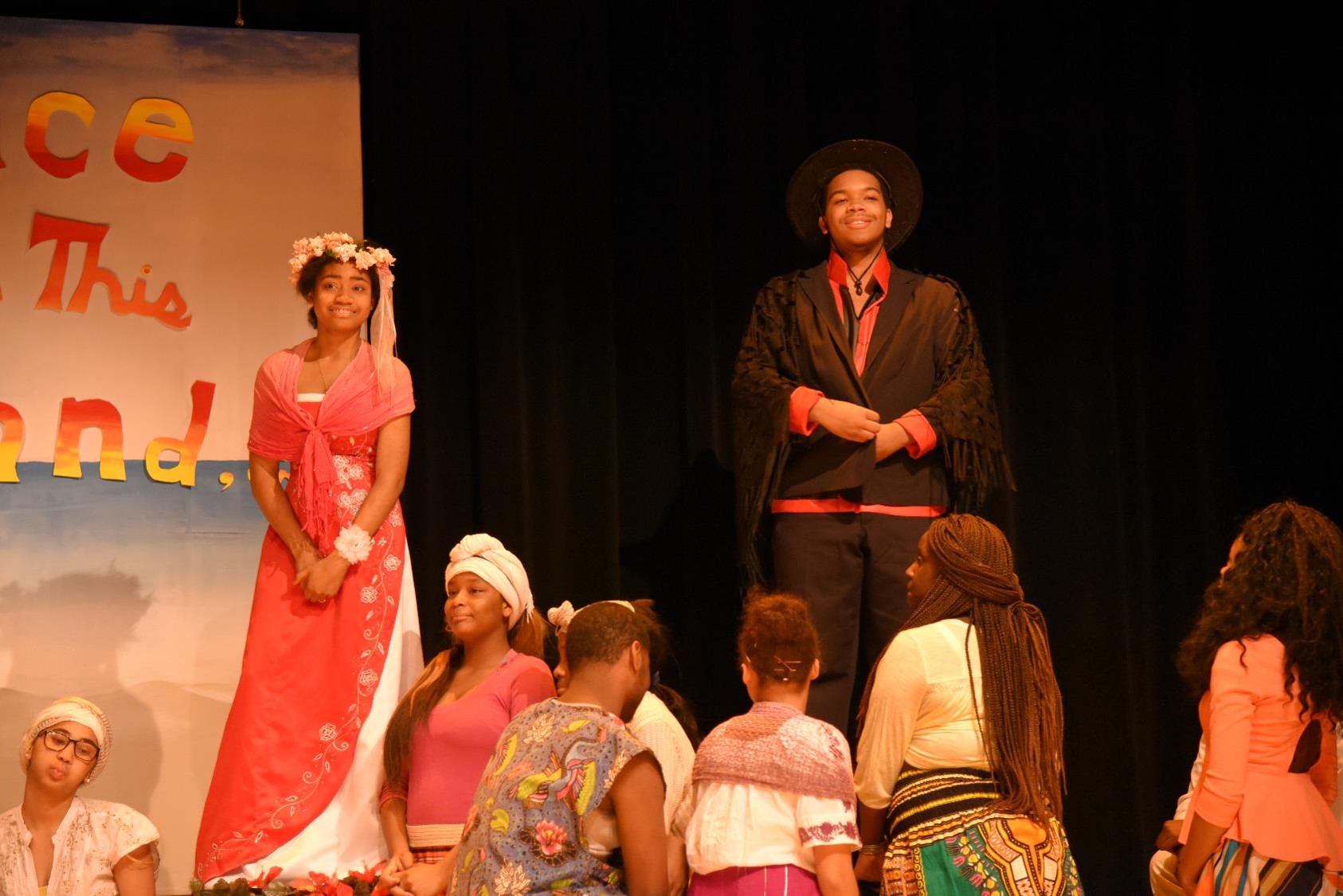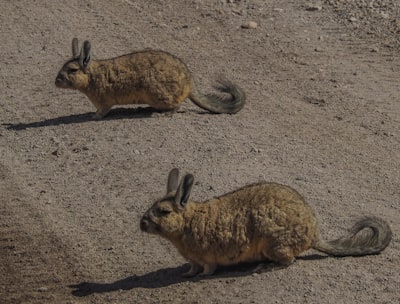
Click to Teach/Click to Learn: Let's Show a Story
In this Click to Teach/Click to Learn lesson for young actors, children experience creating a drama based on a story, using simple mimed actions. Students will be asked to listen to a story, identify beginning, middle and end and to act out some of the action of the story in sequence. Loosely based on the Theatre Educator Pro community resource lesson plan "Acting Out the Actions". This lesson is best suited for students in Grades K-3, but can be adapted for other elementary grades.
Learning Outcomes:
- The learner will be able to identify the beginning, middle and end of a story.
- The learner will be able to identify and act out the actions in a story during a guided drama experience.
Step 1: Get Inspired
A. READ AND THINK

Think of a story you know. Shhh... don't say yet- just think.

B. LISTEN TO YOUR TEACHER

Teacher:
Can you tell me what story you thought of? How do you know that story?
There are lots of ways to learn a story. Someone could read a story to you. You could see a story on television, or you could watch a movie or you could see actors perform a story in a play. Actors don't read stories, they SHOW stories. Actors use their bodies, their imaginations and their voices to create the characters in a story and show what happens to those characters.
In this lesson we are going to learn how actors show a story, and we are going to practice using our own bodies, imaginations and voices to tell a story just like actors in a play.
Step 2: Getting Ready
Teachers note: for this step you may want to have ready a printed copy of the tale of Rabbit and Fox. You can find a copy on the Cherokee Phoenix site here.
A. WATCH
Teacher:
When I asked you to remember a story, I'll bet you began to think about what happened in the story- what came first, what happened next and how it ended. To act out a story we need to be able to know who the characters are and what happens to them. The first stories were told by storytellers. Listen to Native American Gregg Howard tell the story of how Rabbit got his short tail. As you listen to the story, think about what happens- the beginning, the middle and the end. When the story is over, I will ask you all to tell me:
Who are the characters in the story? What happened to them? What happened first? What came next? How did it end?
B. THINK AND SHARE
Teacher:
Now that you have heard the story of How Rabbit Got his Short Tail, let's see if you can answer some questions about the story.
- Who were the characters in the story?
- What was the problem?
- What did Rabbit want? What did Fox want? How did Bear help?
- Tell me more about what happened, what came first? What happened next? How did the story end?
C. DRAW
Draw the characters in the story: Fox, Rabbit and a Bear.
Here are some pictures to help you imagine what your Fox, Rabbit and Bear might look like. Remember, when the story starts, Rabbit has a long tail like the rabbits in this picture.
 |  |  |
D. LISTEN AND DO
Teacher:
When we listen to a storyteller, we imagine what is happening in our minds. Let's try to use our imagination to bring some of the story to life as frozen pictures. First, let's practice freezing together. Not yet, but when I say go, stand up, find a safe place to move where you can't touch anybody or anything but you can still hear me, and wiggle as much as you can until I say "FREEZE". Ready, 1,2,3 GO..... now FREEZE.
Great! Next we are going to make some frozen pictures showing the characters from the story and what happened to them.
First make a frozen picture of Fox carrying all those heavy fish, this is from the beginning of the story.
Ready? 1,2, 3, GO! FREEZE
Great! Relax.
Now make a frozen picture showing a Rabbit who want to have lots of yummy fish, that was in the beginning of the story too.
Ready? 1,2,3 GO! FREEZE
Great! Relax.
Now make a frozen picture of Fox sneaking away while Rabbit sits with a long tail dangling in the lake. That happened in the middle of the story.
Ready? 1,2,3 GO! FREEZE
Great! Relax.
Now make a frozen picture of Rabbit frozen into the lake - poor Rabbit... so COLD! That happened in the middle of the story too.
Ready? 1,2,3, GO! FREEZE
Great! Relax.
Now make a frozen picture of Bear pulling Rabbit out of the lake. That happened at the end of the story.
Ready? 1,3,2, GO! FREEZE!
Great job- now Relax.
Last one, ready? Make a frozen picture of the moment Rabbit discovers the missing tail. That is the last thing that happened in the story.
Ready? 1, 2, 3, GO! FREEZE!
Great work everyone - for next time- I'd like you all to draw the story of How Rabbit Got a Short Tail using your worksheet to show what happened in the beginning, the middle and the end.
View the Beginning, Middle and End worksheet HERE (PDF). Download or print the Beginning, Middle and End worksheet HERE (Word Document).
Step 3: How Actors SHOW a Story
A. SHARE
Teacher: Do you remember how you drew the pictures of what happened in the story of How Rabbit Got a Short Tail? Get out your pictures now to share them and be ready to answer some questions together.
Note to teacher: Students all share their pictures and discuss
B. LISTEN AND DO
Teacher:
Take a look at the pictures you drew of beginning, middle and end. Actors make living pictures, using their bodies, imaginations and voices to show what the characters do, what they want and how they feel. Let's take turns brining our pictures to life- but no talking please, just use your bodies and imaginations. (Teacher coaches students to bring their pictures to life by pantomiming what is happening in the picture as one of the characters.)
That was great! Do you think we can create the whole story together with some living pictures by using our bodies and our imaginations? Let's try it all together. I'll tell the action in the story and you create the living picture.
Show me Rabbit sitting by the side of the road.
Show me Fox walking along with a string of fish.
Show me Fox pointing to the lake where Rabbit could catch fish.
Show me Rabbit sitting very still and very cold with their long tail dangling in the lake.
Show me Rabbit realizing that their tail is stuck.
Show me Rabbit calling for help.
Show me Bear pulling and pulling.
Show me Rabbit very sad because their tail is missing.
Show me Fox hiding in the bushes and laughing.
NOTE TO TEACHER: At this point, the leader is coaching actions from the story, while all children act out this portion of the story by pantomiming what the character is doing. Side coaching should be used to encourage using "feeling faces" to show how the character feels, etc. Continue until the children have acted out all of the major events of the story.
Step 4: Putting it all together
A. WATCH
Let's watch a story together. This is a story of Anansi the Spider and his friend Turtle. Anansi is a very important character from African folklore.
Who are the characters in the story?
What was the problem from the story?
What happened in the beginning, middle, and end of the story?
B. LISTEN AND DO
Teacher:
We are going to take a little break now but I want you to remember what happened in the Anansi story we just watched. When we come back together, be ready to act out the story together. For next time, use your imagination to put on something that reminds you of the character you liked best. It could be something black for Anansi, or something green for turtle, what ever your imagination tells you. When we come back together we are going to act out the story of Anansi and the Turtle together, and everyone will be allowed to pretend to be their favorite- either Anansi or Turtle.
Note to teacher: This could be a break during class to find costume items or this could be a homework assignment. For next time, have ready a copy of the Reader's Theatre Script "Anansi's Feast" by Glen McCarty to read to the children as a guided drama experience. Use coaching to encourage the children to act out the story together as their favorite character. This can be broken into several sessions (Beginning, Middle and End) or for older children may happen all in one session. Use the technique of "Show me Anansi sitting at the table"... etc. to help guide the students through the main events, then reading the story from the script, coach them to mime some of the actions.
C. SHOW
Share your costume and tell who your character is and why you chose what you are wearing or holding.
Teacher:
Now we are going to act out the story of Anansi and Turtle together. I will read all of the parts while we act out the story. Let's practice our living pictures first.
Show me Anansi sitting down to dinner when there is a know at the door.
Show me Turtle at the door sniffing delicious yams.
Show me Anansi pointing to Turtle's dirty hands.
Show me Turtle washing his hands.
Show me Anansi eating and munching.
Show me Turtle showing Anansi his hands again.
Show me Anansi sending Turtle to wash his hands again.
Show me Turtle washing his hands.
Show me Anansi eating the last of the food.
Show me Turtle looking sad, then getting an idea.
Show me Turtle jumping into the water and sitting at the table.
Show me Anansi trying to jump in but only floating.
Show me Turtle eating and munching.
Show me Anansi filling pockets with stones.
Show me Anansi jumping in and swimming to the bottom.
Show me Turtle telling Anansi to remove the coat.
Show me Anansi popping up to the surface.
Show me Turtle enjoying the last of the feast.
Show me Anansi frustrated and HUNGRY!
Great job! Now let's see if you can act out those parts while I read the story to you. Listen for the action and bring your pictures to life, but remember to use only your bodies and your imaginations- no voices this time please.
Note to teacher: Once the children have practiced with the actions shown above, the class can try to perform the actions cued by the teacher reading the script. This can be done in one session or rehearsed and completed in several sessions. Older students may want to perform the story as a Reader's Theatre.
Measuring Learning

Classroom Connections
This lesson is best suited for students in Grades K-3, but can be adapted for other elementary grades.
Grade K
TH:Cr1.1.K.a. With prompting and support, invent and inhabit an imaginary elsewhere in dramatic play or a guided drama experience (e.g., process drama, story drama, creative drama).
TH:Cr1.1.K.b. With prompting and support, use nonrepresentational materials to create props, puppets, and costume pieces for dramatic play or a guided drama experience (e.g., process drama, story drama, creative drama).
TH:Pr4.1.K.a. With prompting and support, identify characters and setting in dramatic play or a guided drama experience (e.g., process drama, story drama, creative drama).
TH:Re7.1.K.a. With prompting and support, express an emotional response to characters in dramatic play or a guided drama experience (e.g., process drama, story drama, creative drama)
Grade 1
TH:Cr1.1.1.c. Identify ways in which gestures and movement may be used to create or retell a story in guided drama experiences (e.g., process drama, story drama, creative drama).
TH:Pr4.1.1.a. Describe a story’s character actions and dialogue in a guided drama experience (e.g., process drama, story drama, creative drama).
TH:Pr5.1.1.a. With prompting and support, identify and understand that physical movement is fundamental to guided drama experiences (e.g., process drama, story drama, creative drama).
TH:Pr6.1.1.a. With prompting and support, use movement and gestures to communicate emotions in a guided drama experience (e.g., process drama, story drama, creative drama).
TH:Re7.1.1.a. Recall choices made in a guided drama experience (e.g., process drama, story drama, creative drama).
Grade 2
TH:Cr3.1.2.b. Use and adapt sounds and movements in a guided drama experience (e.g., process drama, story drama, creative drama).
TH:Pr4.1.2.a. Interpret story elements in a guided drama experience (e.g., process drama, story drama, creative drama).
TH:Pr4.1.2.b. Alter voice and body to expand and articulate nuances of a character in a guided drama experience (e.g., process drama, story drama, creative drama).
TH:Pr6.1.2.a. Contribute to group guided drama experiences (e.g., process drama, story drama, creative drama) and informally share with peers.
TH:Re7.1.2.a. Recognize when artistic choices are made in a guided drama experience (e.g., process drama, story drama, creative drama)
Grade 3
TH:Cr3.1.3.b. Participate and contribute to physical and vocal exploration in an improvised or scripted drama/theatre work.
TH:Pr4.1.3.a. Apply the elements of dramatic structure to a story and create a drama/theatre work.
TH:Pr4.1.3.b. Investigate how movement and voice are incorporated into drama/theatre work.
TH:Re7.1.3.a. Understand why artistic choices are made in a drama/theatre work.
| Access Date | Quiz Result | Score | Actions |
|---|
Learning Center
- Webinars
- Adjudication Trainings
- Featured Courses
- Full Course List
- Lesson Plan Library
- Click to Teach Interactive Online Lessons
- Resources for New Theatre Teachers
- Technical Theatre Educator's Manual
- Connected Arts Networks
- Diverse Resources for Theatre Education
- Behind the Scenes Technical Theatre Curriculum
- Social & Emotional Learning
- Additional Standards Based Instructional Resources
- Search the Catalog
- Cart (0 items)
Full Site Search
Membership Benefits
Join EdTA for full access to our professional development and standards-based teaching resources, including:
- 300+ lesson plans
- Click to Teach online lessons
- K-12 curriculum
- Webinars
- And more!




